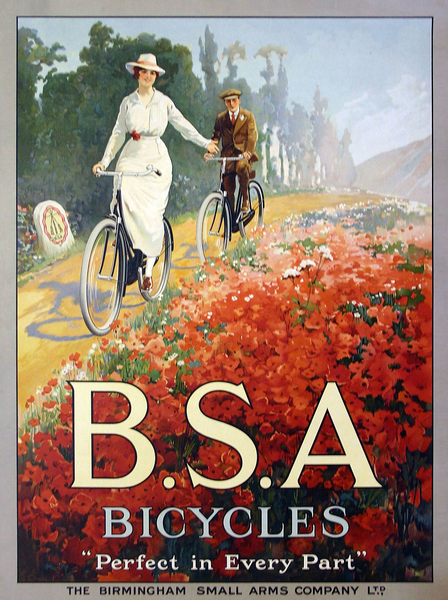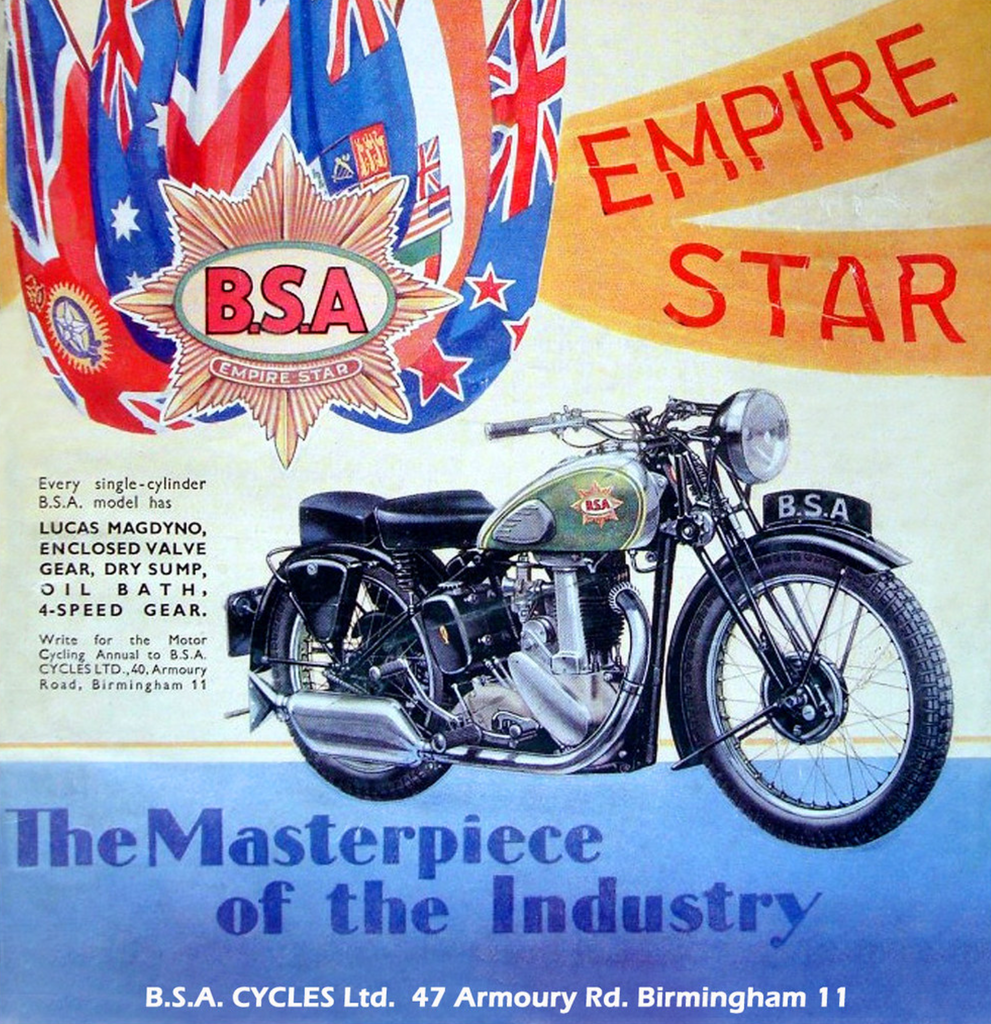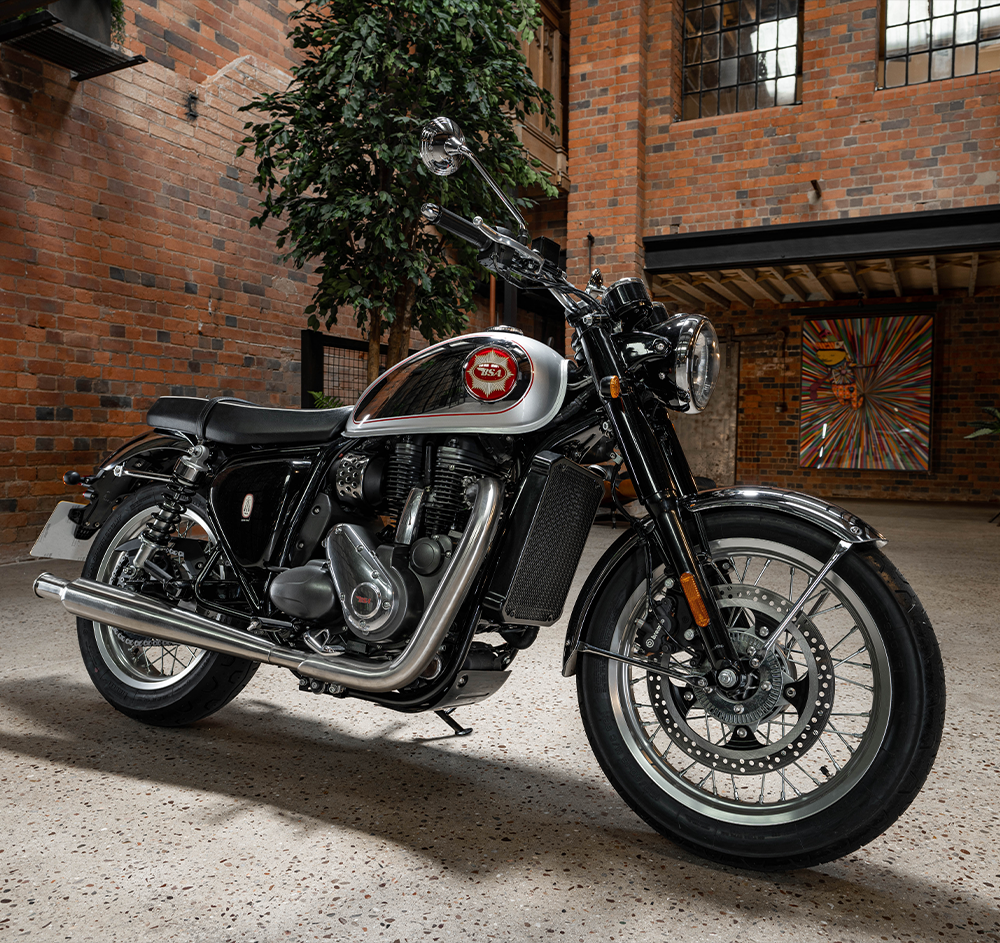
One of the highlights of the 007 movie "Thunderball" was the sight of leather-clad Bond girl Fiona Volpe (played by Luciana Paluzzi) astride a BSA A65 Lightning motorcycle, firing rockets from its fairing-mounted missile launcher to destroy Count Lippe's car that was in pursuit of Bond's Aston.
The Lightning model was introduced in 1965 (the year the film was released) and production continued until 1972, when financial problems led to the closure of what had once been the world's largest motorcycle manufacturer. However, after a half-century hiatus, the legendary British brand has made a comeback.

The earliest BSA trademark
The Birmingham Small Arms Company Limited (BSA) began in June 1861 in the Gun Quarter of the West Midlands city of Birmingham. It was formed by a group of fourteen gunsmiths who intended to mass-produce rifles by machine - little wonder the company was adept at adding missile launchers to motorcycles in later years. The company discovered that the market for small arms could be somewhat erratic. Being busy with military contracts when countries were preparing for war, but quiet when they were not, led to the factory's temporary closure in 1879.

The Small Heath and Redditch premises of BSA (1862)
The following year, BSA was approached by Messrs Smith and Lamb of Ipswich, with a request to manufacture the Otto Patent Safety Dicycle (not "Bi" cycle) the invention of Mr E.C.F. Otto. On 2nd July, 1880, a contract was entered into whereby the company undertook to supply 210 'Ottos' at £8 15s. each, less tyres: the first machine was delivered on 20th September, 1880.

The Otto Patent Safety Dicycle (1880)
The business went on to produce parts for other cycle companies before creating its own safety-bicycle that was sold under the BSA brandname. Production ceased in 1887 in order to concentrate on manufacturing the Lee-Metford magazine-loading rifle for the War Office, which was re-equipping the British Army, but the manufacture of bicycles recommenced in 1908.

Early advertisement for BSA Safety-Bicycles
In 1910, motor-bicycles were added to the company's product catalogue. The BSA 3 1⁄2 hp was presented at the Olympia Cycle & Motor Show on 21st November 1910 for the 1911 season. All production was sold out for 1911, 1912 and 1913, but the onset of the First World War saw the company return to arms manufacture, supporting the war effort with rifles, Lewis guns, ammunition, bicycles and motor-bicycles, together with aero engines, aircraft and other vehicles manufactured by Daimler - who they had acquired in 1910.

BSA 3 1⁄2 hp Motor Bicycle advertisement (1912)
Post War production of motorcycles returned to BSA in 1919 with the introduction of their first 50 degree V-twin "Model E" 770cc side valve (6–7 hp) for the 1920 season. There was an enormous appetite for affordable transport after the end of the war and the Model E became popular - particularly with BSA's matching green and cream painted sidecar option. Increased demand saw the whole of the Small Heath manufacturing facility in Birmingham turn entirely to motorcycle production.

1920 BSA Model E and Sidecar
By the 1930s, BSA had built a global reputation for producing well-made, dependable and competitively priced motorcycles. The company slogan read, "One in Four is a BSA", proudly defining their position as the world's most popular motorcycle brand. In 1932, the company introduced the Blue Star range of sportier, more powerful motorcycles producing 28hp! An uprated model was introduced in 1936, named the Empire Star (to commemorate the Silver Jubilee of King George V) and was produced until 1939, when it was further developed into the Gold Star before production was halted by another war.

BSA Empire Star advertisement (1936)
At the outbreak of the Second World War, BSA was the sole UK rifle manufacturer, and armaments again became the company's main focus - with the production of equipment such as Browning machine guns peaking at 16,390 per month by March 1942. In addition, the armed forces made the 500cc BSA M20 their motorcycle of choice, and 126,000 of the machines saw active service. The M20 was a reliable and affordable motorcycle, and post-war production continued until the mid 1950s.

BSA wartime advertisement
Following the war-years, BSA expanded its range of motorcycles and in 1951 acquired its main competitor, Triumph. Three years earlier, a lightweight motorcycle had been added to the BSA line-up and it was to become the company's best-selling model. The Bantam was a simple, two-stroke, single-cylinder machine, produced by BSA from 1948 (originally as a 125cc machine) up to 1971 (by which time it had grown to 175cc). Although often considered to be an archetypal ‘British’ motorcycle, it was actually based on the German DKW RT125, a design that was received by BSA as post-WWII war reparations. Exact production figures are unknown, but estimates range from 250,000 to 500,000 across the model's 23 year lifespan. Click here to read more about the Bantam.

BSA Bantam advertisement (1949)
Whilst the Bantam was wildly popular, it is the Gold Star that undoubtedly remains the icon of BSA's family of motorcycles. The pre-war model was continually developed throughout its lifetime, and became one of the fastest bikes of the 1950s. The origin of the name dates back to 1937, when Wal Handley lapped Brooklands at over 100mph on a BSA Empire Star and was awarded a ‘Gold Star’ pin in recognition. Production spanned 50 years, ending in 1963, after which the dominance of BSA's position in the motorcycle market went into decline. Within a decade, a government-organised rescue operation led to the takeover of BSA motorcycle operations by Norton-Villiers, and whilst attempts were made to resuscitate the brand, it was eventually laid to rest.

1962 BSA Gold Star
Fifty years after its demise, BSA was relaunched under the ownership of Indian multinational conglomerate, Mahindra, and the first new model has been respectfully named the Gold Star. The British design has a water-cooled, fuel-injected, single-cylinder, 652cc engine, with Brembo ABS and LED lights, but at first glance it looks as though it could've rolled off the Small Heath production line in the 1950s. Initial reviews have been positive, and we hope that those who appreciate retro styling, together with modern reliability and performance, will soon discover that a Star has been reborn.

The 2023 BSA Gold Star
Click here to read more about BSA motorcycles.
